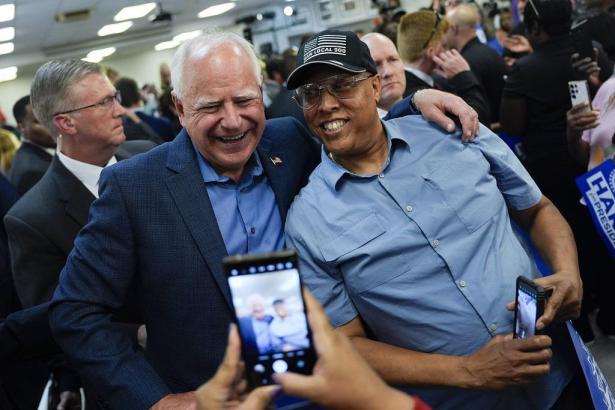Since being picked as Vice President Kamala Harris’s running mate, Minnesota Gov. Tim Walz has been lauded as a champion for workers. Unions have cheered the selection and Harris’s introduction at their first campaign rally together specifically called out Walz’s efforts on behalf of working families.
As the national audience continues to dig through his record, it’s worth asking the question: How did working Minnesotans do during Walz’s time as governor? Like Walz’s fellow teachers ask students to do every day, I checked the math.
Let’s start with jobs. Following a dramatic decline during the pandemic, Minnesota’s total employment reached a historically high three million jobs in 2023. Underscoring the strength of the state’s labor market, unemployment currently stands below its pre-pandemic level at 2.9 percent, more than a full point below the national average. Further analysis shows that this low unemployment rate is not being driven by people giving up on working; Minnesota’s 68.3 percent labor force participation rate ranks fifth in the nation.
Building on this success, Walz has signed several new policies into law to continue boosting employment. These include historic investments in infrastructure and mass transit, workforce development programs for nurses to help meet the state’s future health care needs, and a clean-energy agenda that will put Minnesotans to work combating climate change.
The proof can be seen in Minnesota boasting the highest median wage in the Midwest, with inflation-adjusted wages growing by 8 percent since 2019.
Creating jobs is important, but job quality is equally crucial. Fortunately for Minnesota workers, Walz has pushed family-sustaining employment.
The proof can be seen in Minnesota boasting the highest median wage in the Midwest, with inflation-adjusted wages growing by 8 percent since 2019. Gains have been even stronger for low-wage workers, who saw their real wages rise 13 percent in that time, outpacing the wage increases experienced by Minnesota’s wealthy. Perhaps most astonishingly, the share of workers earning poverty wages has declined by over 30 percent since Walz took office.
Workers know that a good job is not just about fair pay, but also solid benefits. Here again, the stats are strong. Minnesota holds the second-highest rate of employer-provided health care in the country, contributing to the nation’s third-best life expectancy.
Far from resting on these accomplishments, Walz has continued advocating for workers to be treated better. Unlike most of the country, Minnesota workers no longer must choose between putting food on the table and taking care of themselves and their loved ones, thanks to the state’s new guaranteed paid sick time and paid family and medical leave. Walz’s efforts have further involved a first-in-the-nation prevailing-wage requirement for low-income housing projects, ensuring more people can live in the communities where they build homes.
One reason that Minnesota sustains such high-quality jobs is because of organized labor’s strength in the state. For the fourth consecutive year, Minnesota led the Midwest in union membership, with particularly pronounced gains in union membership among people of color.
Bolstering these efforts, Walz has banned “captive audience” meetings that are used to block workplace organizing and outlawed noncompete agreements that keep workers stuck in jobs. Through the Nursing Home Workforce Standards Board, Walz has given voice to the workers tasked with caring for seniors. It turns out that when workers are supported by their government, they do better.
And while some might claim that worker strength scares off would-be employers, the facts suggest otherwise. Minnesota was ranked the fifth-best state for business in 2023, reflecting the commonsense idea that satisfied workers create more successful companies.
To be sure, there is room for improvement. Racial, ethnic, and gender disparities have long plagued the North Star State. Today, women in Minnesota take home 83 cents on every dollar earned by men. White Minnesotans are more than twice as likely as Black Minnesotans to have employer-provided health insurance, creating the largest racial gap in the country.
But even here, progress is being made. In 2008, Black Minnesotans had the highest unemployment rate in the country. Today, Minnesota’s Black unemployment rate is the tenth-lowest. Walz has promoted programs to continue closing the state’s long-standing racial and ethnic inequalities, including more funding to recruit teachers of color and large investments in Tribal Colleges.
All of this is to take nothing away from Walz’s policies that help working people more indirectly, like free school meals for their kids, gun control laws that make their communities safer, and electoral reforms that make it easier for workers to vote. It is also important to recognize that Walz did not accomplish any of this on his own, but rather demonstrated his capacity to work with legislative and community leaders to enact this pro-worker agenda.
Critics will surely suggest that Walz’s working-man persona is superficial. Wearing flannel and helping people dig cars out of the snow does not make him a champion for the everyday person. But delivering real results does. When it comes to Walz’s dedication to workers, the numbers don’t lie.


Spread the word